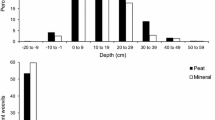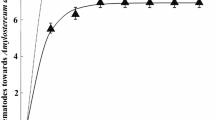Abstract
Entomopathogenic nematodes (EPN) applied inundatively to suppress insect pests are more likely to persist and establish in stable agroecosystems than in annual crops. We investigated a system of intermediate stability: three stumps harbouring the large pine weevil (Hylobius abietis L.; Coleoptera: Curculionidae), a major European forestry pest. We tested whether persistence of EPN Steinernema carpocapsae Weiser (Rhabditida: Steinernematidae) applied around stumps is maintained by recycling of EPN through pine weevils developing within stumps. Steinernema carpocapsae was detected in soil around and under the bark of treated tree stumps up to two years, but not 4–5 years after application. Differences in nematode presence between sites were better explained by tree species (pine or spruce) than soil type (mineral or peat). Presence of S. carpocapsae in soil was positively correlated with the number of H. abietis emerging from untreated stumps the previous year, which was greater for pine stumps than spruce stumps.


Similar content being viewed by others
References
Adams BJ, Nguyen KB (2002) Taxonomy and systematics. In: Gaugler R (ed) Entomopathogenic nematology, 1st edn. CAB publishing, Wallingford, pp 1–35
Anon. (2003) National inventory of woodland and trees. Forestry Commission, Wexford
Anon. (2007) National forest inventory Republic of Ireland. Forest Service, Midlothian
Bathon H (1996) Impact of entomopathogenic nematodes on non-target Hosts. Biocontrol Sci Technol 6:421–434
Brixey JM, Moore R, Milner AD (2006) Effect of entomopathogenic nematode (Steinernema carpocapsae Weiser) application technique on the efficacy and distribution of infection of the large pine weevil (Hylobius abietis L.) in stumps of Sitka spruce (Picea sitchensis Carr.) created at different times. For Ecol Manage 226:161–172
Butterfield J (1997) Carabid community succession during the forestry cycle in conifer plantations. Ecography (Cop.) 20:614–625
Campbell JF, Lewis E, Yoder F, Gaugler RJ (1995) Entomopathogenic nematode (Heterorhabditidae and Steinernematidae) seasonal population dynamics and impact on insect populations in turfgrass. Biol Control 5:598–606
Dillon AB (2003) Biological control of the large pine weevil, Hylobius abietis L., (Coleoptera: Curculionidae) using entomopathogenic nematodes. In: Ph.D. thesis submitted at National University of Ireland Maynooth, Ireland
Dillon AB, Ward D, Downes MJ, Griffin CT (2006) Suppression of the large pine weevil Hylobius abietis (L.) (Coleoptera: Curculionidae) in pine stumps by entomopathogenic nematodes with different foraging strategies. Biol Control 38:217–226
Dillon AB, Downes MJ, Ward D, Griffin CTJ (2007) Optimizing application of entomopathogenic nematodes to manage large pine weevil, Hylobius abietis L. (Coleoptera: Curculionidae) populations developing in pine stumps, Pinus sylvestris. Biol Control 40:253–263
Dillon AB, Rolston AN, Meade CV, Downes MJ, Griffin CT (2008a) Establishment, persistence, and introgression of entomopathogenic nematodes in a forest ecosystem. Ecol Appl 18:735–747
Dillon AB, Moore CP, Downes MJ, Griffin CT (2008b) Evict or infect? Managing populations of the large pine weevil, Hylobius abietis, using a bottom-up and top-down approach. For Ecol Manage 255:2634–2642
Dillon AB, Foster A, Williams CD, Griffin CT (2012) Environmental safety of entomopathogenic nematodes—effects on abundance, diversity and community structure of non-target beetles in a forest ecosystem. Biol Control 63:107–114
Fahy O, Gormally M (1998) A comparison of plant and carabid beetle communities in an Irish oak woodland with a nearby conifer plantation and clearfelled site. For Ecol Manage 110:263–273
Gaugler R (1988) Ecological considerations in the biological control of soil-inhabiting insects with entomopathogenic nematodes. Agric Ecosyst Environ 24:351–360
Glazer I (1992) Survival and efficacy of Steinernema carpocapsae in an exposed environment. Biocontrol Sci Technol 2:101–107
Grewal PS, Ehlers RU, Shapiro-Ilan DI (eds) (2005) Nematodes as biocontrol agents, 1st edn. CAB Publishing, Wallingford
Griffin CT (2015) Behaviour and population dynamics of entomopathogenic nematodes following application. In: Campos Herrera R (ed) Nematode pathogenesis of insects and other pests—ecology and applied technologies for sustainable plant and crop protection, 1st edn. Springer, Berlin, pp 57–95
Griffin CT, Moore JF, Downes MJ (1991) Occurrence of insect-parasitic nematodes (Steinernematidae, Heterorhabditidae) in the Republic of Ireland. Nematologica 37:92–100
Gwynn RL, Richardson PN (1996) Incidence of entomopathogenic nematodes in soil samples collected from Scotland, England and Wales. Fundam Appl Nematol 19:427–431
Harvey CD, Griffin CT (2012) Host activity and wasp experience affect parasitoid wasp foraging behaviour and oviposition on nematode-infected larvae of the forestry pest Hylobius abietis. Ecol Entomol 37:269–282
Harvey CD, Alameen KM, Griffin CT (2012) The impact of entomopathogenic nematodes on a non-target, service-providing longhorn beetle is limited by targeted application when controlling forestry pest Hylobius abietis. Biol Control 62:173–182
Hodson AK, Siegel JP, Lewis EE (2012) Ecological influence of the entomopathogenic nematode, Steinernema carpocapsae, on pistachio orchard soil arthropods. Pedobiologia 55:51–58
Irwin S, Pedley S, Coote L, Dietzsch A, Wilson M, Oxbrough A, Sweeney O, Moore K, Martin R, Kelly D, Mitchell FG, Kelly T, O’Halloran J (2014) The value of plantation forests for plant, invertebrate and bird diversity and the potential for cross-taxon surrogacy. Biodivers Conserv 23:697–714
Kaya HK, Gaugler R (1993) Entomopathogenic nematodes. Annu Rev Entomol 38:181–206
Klein MG, Georgis R (1992) Persistence of control of Japanese Beetle (Coleoptera: Scarabaeidae) larvae with steinernematid and heterorhabditid nematodes. J Econ Entomol 85:727–730
Koppenhöfer AM, Fuzy EM (2009) Long-term effects and persistence of Steinernema scarabaei applied for suppression of Anomala orientalis (Coleoptera: Scarabaeidae). Biol Control 48:63–72
Kung SP, Gaugler R, Kaya HK (1990) Soil type and entomopathogenic nematode persistence. J Invertebr Pathol 55:401–406
Långström B, Day KR (2004) Damage, control and management of weevil pests, especially Hylobius abietis. In: Leutier F (ed) Bark and wood boring insects in living trees in Europe, a synthesis, 1st edn. Springer, Berlin, pp 415–444
Leather SR, Day KR, Salisbury AN (1999) The biology and ecology of the large pine weevil, Hylobius abietis (Coleoptera: Curculionidae): a problem of dispersal? Bull Entomol Res 89:3–16
Månsson PE, Schlyter F (2004) Hylobius pine weevils adult host selection and antifeedants: feeding behaviour on host and non-host woody scandinavian plants. Agr For Entomol 6:165–171
Niemelä J, Koivula MKDJ (2007) The effects of forestry on carabid beetles (Coleoptera: Carabidae) in boreal forests. J Insect Conserv 11:5–18
Niemelä J, Langor D, Spence JR (1993) Effects of clear-cut harvesting on boreal ground-beetle assemblages (Coleoptera: Carabidae) in Western Canada. Conserv Biol 7:551–561
Nordenhem H (1989) Age, sexual development, and seasonal occurrence of the pine weevil Hylobius abietis (L.). J Appl Entomol 108:260–270
Örlander G, Nilsson U, Nordlander G (1997) Pine weevil abundance on clear-cuttings of different ages: a 6-year study using pitfall traps. Scand J For Res 12:225–240
Pawson SM, Brockerhoff EG, Norton DA, Didham RK (2006) Clear-fell harvest impacts on biodiversity: past research and the search for harvest size thresholds. Can J For Res 36:1035–1046
Peters A (1996) The natural host range of Steinernema and Heterorhabditis spp. and their impact on insect populations. Biocontrol Sci Technol 6:389–402
Poinar GO, Hom A (1986) Survival and horizontal movement of infective stage Neoaplectana carpocapsae in the field. J Nematol 18:34–36
Preisser EL, Dugaw CJ, Dennis B, Strong DR (2005) Long-term survival of the entomopathogenic nematode Heterorhabditis marelatus. Env Entomol 34:1501–1506
Pye AE, Burman M (1978) Neoaplectana carpocapsae: Infection and reproduction in large pine weevil larvae, Hylobius abietis. Exp Parasitol 46:1–11
Rice WR (1989) Analyzing tables of statistical tests. Evolution 43:223–225
Shields EJ, Testa A, Miller JM, Flanders KL (1999) Field efficacy and persistence of the entomopathogenic nematodes Heterorhabditis bacteriophora Oswego and H. bacteriophora NC on Alfalfa Snout Beetle larvae (Coleoptera: Curculionidae). Environ Entomol 28:128–136
Sippola AL, Siitonen J, Punttila P (2002) Beetle diversity in timberline forests: a comparison between old-growth and regeneration areas in Finnish Lapland. Ann Zool Fennici 39:69–86
Smits PH (1996) Post-application persistence of entomopathogenic nematodes. Biocontrol Sci Technol 6:379–388
Susurluk A, Ehlers R-U (2008) Field persistence of the entomopathogenic nematode Heterorhabditis bacteriophora in different crops. BioControl 53:627–641
Torr P, Heritage S, Wilson MJ (2007) Steinernema kraussei, an indigenous nematode found in coniferous forests: efficacy and field persistence against Hylobius abietis. Agric For Entomol 9:181–188
van Lenteren JC, Babendreier D, Bigler F, Burgio G, Hokkanen HMT, Kuske S, Loomans AJM, Menzler-Hokkanen I, van Rijn PCJ, Thomas MB, Tommasini MG, Zeng QQ (2003) Environmental risk assessment of exotic natural enemies used in inundative biological control. BioControl 48:3–38
Williams CD, Dillon AB, Girling RD, Griffin CT (2013) Organic soils promote the efficacy of entomopathogenic nematodes, with different foraging strategies, in the control of a major forest pest: A meta-analysis of field trial data. Biol Control 65:357–364
Acknowledgments
We thank the Irish Environmental Protection Agency (EPA) and the Department of Environment, Heritage and Local Government (DoEHLG) for support. This study was funded by the EPA STRIVE Programme (Project Code 2007-PhD-B-6) under the National Development Plan 2007–2013. Nematodes were applied under license (TA003) from the Pesticide Control Services of the Irish Department of Agriculture and Food. Coillte Teoranta provided clearfell sites and Dr Aoife Dillon at the Coillte Forest Protection Section provided information and technical advice on the sites.
Author information
Authors and Affiliations
Corresponding author
Additional information
Handling Editor: Ralf Ehlers.
Rights and permissions
About this article
Cite this article
Harvey, C.D., Griffin, C.T. Local host-dependent persistence of the entomopathogenic nematode Steinernema carpocapsae used to control the large pine weevil Hylobius abietis . BioControl 61, 185–193 (2016). https://doi.org/10.1007/s10526-015-9709-9
Received:
Accepted:
Published:
Issue Date:
DOI: https://doi.org/10.1007/s10526-015-9709-9




